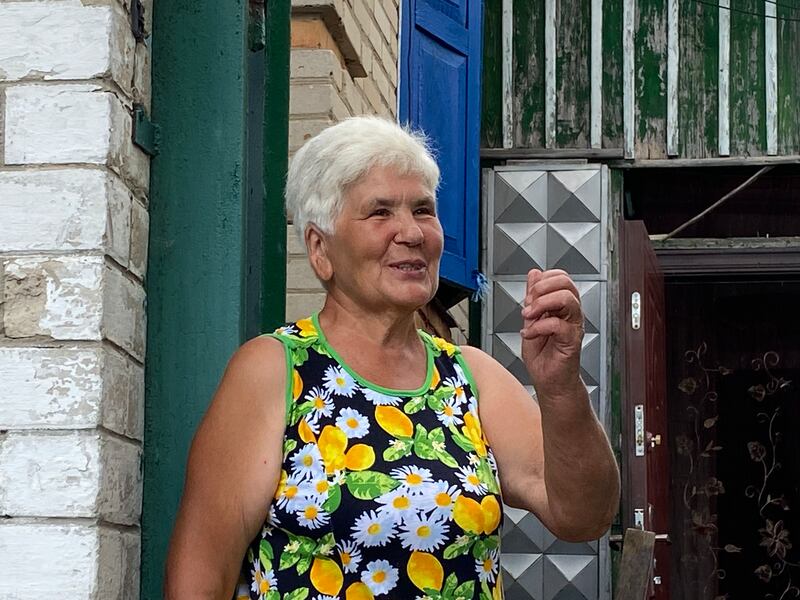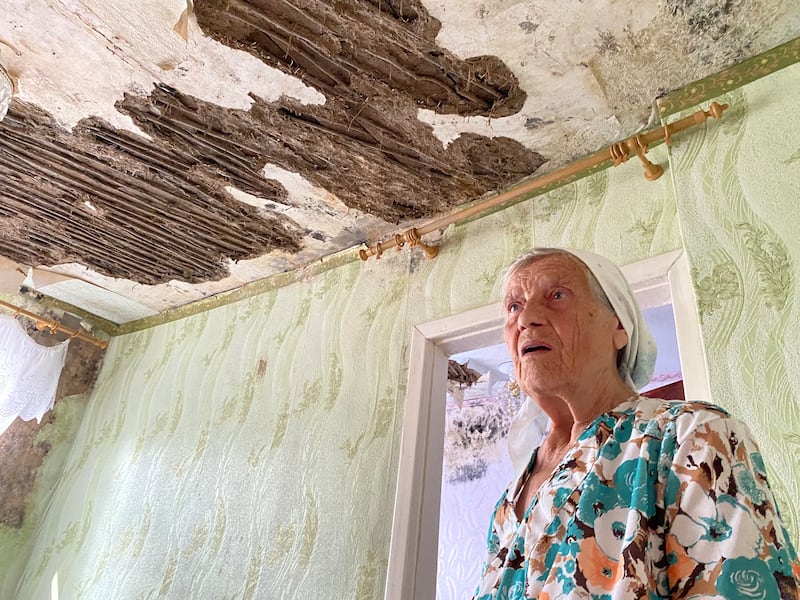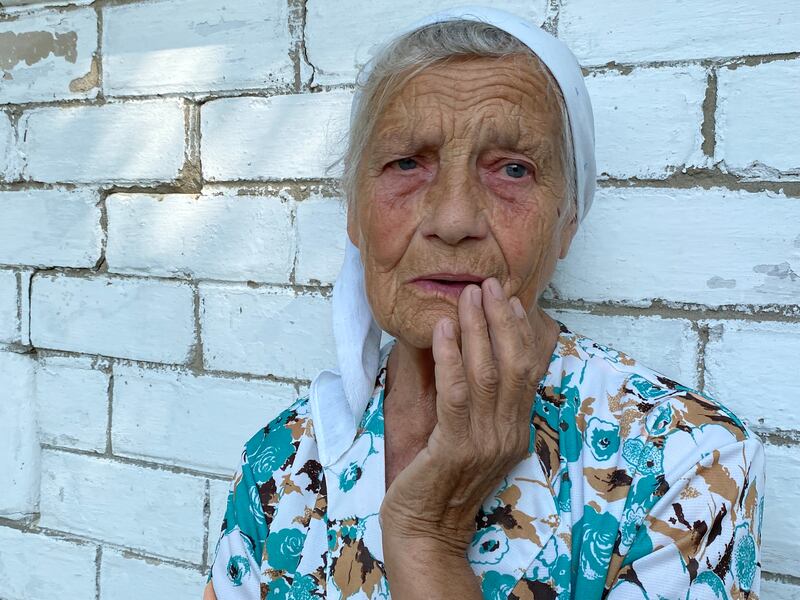When the Russians invaded Ukraine almost everyone fled the string of villages along the railway line to Belgorod, save for a few old people. “Old trees cannot be replanted because they have deep roots,” a woman in her 80s told an aid worker who came to evacuate her.
Each time this territory changed hands it was bombarded. The road is still chewed up by tank treads and the letter Z, the mark of the Russian army, is omnipresent.
As we approach Tsyupivka, 18km from the Russian border, there’s a rusting tank in the ditch to the left. An icon of Christ appears eerily in a shell hole in the Orthodox church. I am warned not to walk on the grass because the Russians carpeted the countryside with butterfly-shaped mines the size of a hand. They maim rather than kill and are poetically called petals.
Tsyupivka’s pre-war population was 1,000. It is about 190 now. Elderly citizens who were evacuated were often the first to return. The pull of their roots was too strong, the house and garden invested with a lifetime of memories.
At the entry to the village, amid derelict vehicles and collapsed cottages, stands a house with a brand-new tin roof. It belongs to the border guard and was the first to be restored here, thanks to a bureaucracy-free NGO called Livyj Bereh (Left Bank), run by three friends from Kyiv in their 30s.
Vlad Sharapa, a cheerful 37-year-old, was restless and eager to travel the world before the full-scale invasion. He thought he had given up construction. His friend Ihor Okuniev (34) was a multimedia artist and graphic designer. The two men joined the wave of solidarity that saw residents of Kyiv ferrying food and supplies to communities liberated from the Russians. Along the way, they met Kseniia Kalmus, a 35-year-old florist.

The three wanted to offer more than short-term assistance. They noticed that the foundations and some walls of apparently destroyed houses were still intact. “The roofs were the greatest problem, because damaged roofs leak and wreck the ceiling and furniture,” Vlad says. “If you replace the roof, people can live in their house and the rest follows.”
“It shows the world that Ukrainians are not just sitting waiting for help,” says Ihor.
The three teamed up to buy roof slates but quickly switched to tin sheeting, which is cheaper and more easily transported. They hire local labour, to revive the economy, and average a new roof each day. Donations come from US and German charities, and from the Pink Floyd guitarist David Gilmour.
[ Ukraine hails use of new long-range weapon and cardboard drones against RussiaOpens in new window ]
“The average roof costs €2,000, about one fifth the total cost of renovating a house,” Vlad says. “We give priority to people who stayed behind in villages, mainly old-age pensioners and the vulnerable, then the people who want to come back.”
“We interview people and draw up a list,” Kseniia explains.
Vera Stozhenko, a widow aged 67, appears in the doorway of her clay brick house. “My roof was hit five times,” she says. “I finally left when it collapsed. I came back to my nest last February, and they rebuilt my roof in June.”

Furniture damaged by shrapnel and water is stacked along the exterior walls. “I’m afraid the Russians will come back, so I’ll wait to replace it,” Vera says. “They shell the next village up the road all the time. I heard explosions yesterday.”
Are the generous roof-builders not afraid their work will be for naught, if fighting resumes here? “That’s not what it’s about,” Vlad says. “We give hope to people, and they believe that somebody cares about them. They call their sons on the frontline and say, ‘The roof is not leaking’. It’s the best energy.”
If the Russians return, Vera says she will flee. “I’m an ethnic Russian, but there’s no way I could stay with them. They did too much evil. They wanted to evacuate us to Russian villages. They were in the village school and at the end of the street. They used curse words and they said, ‘When the Ukrainians come, they will shell the hell out of you.’ They strung a communications wire in front of my house, and they told me, ‘If the wire is cut we will shoot you.’”
Vera’s face lights up when Vlad, Ihor and Kseniia arrive. “Spasiba, spasiba, spasiba!” Thank you, thank you, thank you, she says, blowing kisses. Like nearly everyone in the region, she speaks Russian. The volunteer humanitarians beam back at her.
Vera’s next-door neighbour picks her way towards us gingerly, feeling her way along the wall. “I don’t have a roof,” says Nadia Kadnichanska (79). Her sad story spills out. “The Russians parked two armoured vehicles in the road there, with guns pointed in both directions.”

Nadia starts crying. “My husband Mykola died just before the war. In the summer, my son Dmytro died.”
Vera picks up where Nadia left off. “Her son evacuated us on May 7th [2022]. He did one trip and came back to evacuate the others. The Russians beat him because he violated the curfew. He was so badly injured that he spent nearly three months in bed. Then he died.”
[ Shelling kills at least four people in UkraineOpens in new window ]
The red Niva car that Dmytro used to evacuate the elderly residents of Tsyupivka lies abandoned in the road. An old truck perches on its axles in front of Nadia’s gate. The Russians looted the wheels.
“I have another son and a daughter in Moscow, but I am all alone here,” Nadia sobs. “When they evacuated me to Rivne, I had a phone and we talked. My son was too afraid to say anything. Here there is no connection... I can never forgive Russia. I don’t have long to live now... It would be easier if I had a roof. The winter will come fast.”

Ihor promises her a roof before winter.
A little farther down Tsyupivka’s rutted main road, Vlad, Ihor and Kseniia point out another tin roof. A shirtless old man stands in the doorway, grinning. “That was the second roof we built, after the border guard’s. Afterwards, the others told us he collaborated with the Russians,” Vlad says. Would they have replaced the roof anyway? Vlad shrugs. “Maybe they were jealous. Anyway, he’s an old man. I guess so.”




















